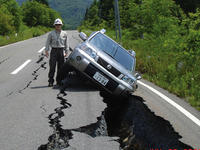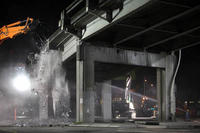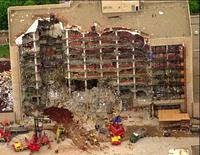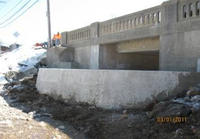-
Using river sediment to repair the coast

The water of the Mississippi River swells beyond levees and flood-control barriers, flooding large areas, destroying costly infrastructure assets, and inflicting economic harms; not all is bad, though: large floods like the current one carry huge quantities of sediment that eventually deposit on the riverbed, making the river shallower, or are carried out to the Gulf of Mexico; the vast amount of water going south will replenish Louisiana’s coastal wetlands, and the sediment carried by the water will restore long stretches of eroding coastline and rebuild barrier islands in the Gulf
-
-
Barge traffic resumes on Mississippi River

On a typical day, some 600 barges move back and forth along the Mississippi, with a single vessel carrying as much cargo as 70 tractor-trailers or 17 rail cars; the barges haul coal, timber, iron, steel, and more than half of America’s grain exports; interruptions of barge traffic could thus cost the U.S. economy hundreds of millions of dollars for each day the barges are idled; early Tuesday the Coast Guard halted barge and cargo haulers traffic along a 15-mile stretch of the river near Natchez, Mississippi; the Coast Guard and the Army Corps of Engineers were worried that the heavy wake churned by barges and cargo haulers increase the pressure on levees which are already straining to hold back the rising river; on Tuesday night the Coast Guard re-opened the blocked section, and barges were allowed to go through but only one at a time, and at a very low speed
-
-
More American civil engineers deployed to Japan to study damage

Last week the American Society of Civil Engineers (ASCE) deployed two more disaster assessment teams to Japan to study the damage wrought by the 11 March earthquake and tsunami; the two teams, the third and fourth deployed by ASCE, will tour the damaged areas which include the approximately 292 square miles inundated by the tsunami; one team will focus on examining the effects that the tsunami and earthquake had on port structures; the other team will focus their efforts on investigating the impact of the earthquake and tsunami on coastal structures like tsunami walls, breakwaters, and seawalls
-
-
U.S. mayors want greater input in federal transportation funding decisions
Last week the U.S. Conference of Mayors (USCM) released the results of a recent survey of mayors in 176 cities on local infrastructure investment; the study revealed that mayors want the federal government to spend more money on infrastructure projects in metropolitan areas rather than highway expansion projects; 96 percent of mayors believed the federal government needed to increase spending on transportation infrastructure to fix rapidly deteriorating public infrastructure; a strong majority supported raising the gas tax to provide additional funds to improve infrastructure
-
-
Rebuilding Seattle's viaduct will not result in nightmare commutes

Debate about how to replace Seattle’s deteriorating waterfront highway has centered on uncertainties in the project’s price tag; drilling a deep-bore tunnel and building an underground highway is estimated to cost around $4 billion, but some worry the final price could be higher, as it was for Boston’s infamous Big Dig; University of Washington statisticians have, for the first time, explored a different subject of uncertainty, namely: how much commuters might benefit from the project
-
-
California roads to generate renewable energy
California lawmakers recently passed a bill for a pilot program that would turn road vibrations into energy; the bill proposes using a process called piezoelectric generation that captures energy from cars, trains, or people as they move across surfaces and create vibrations; these vibrations are then harnessed and converted into energy by piezoelectric materials that would be buried beneath the road’s surface; a .6 single lane road can prove as much as forty-four megawatts of energy each year, which is enough to light up more than 30,000 homes
-
-
California school building regulators had ties with anti-regulation lobby group
A California watchdog group recently revealed that state officials in charge of enforcing earthquake standards for school buildings have had a long and questionable relationship with a lobbying group that actively works to oppose building safety regulations in public schools; senior officials with the Division of the State Architect had been dues paying members of the Coalition for Adequate School Housing, which actively lobbies for less regulation on school construction; in 1997, state regulators were told that taxpayers would reimburse their membership dues to be a part of the lobbying group; officials maintain that there has been no corruption; in 2010 a major regulatory provision in place since 1933 was removed
-
-
Recycled concrete saves money
Purdue University civil engineers are working with the Indiana Department of Transportation to perfect the use of recycled concrete for highway construction, a strategy that could reduce material costs by as much as 20 percent; “If you are going to pave, you may have to remove the old concrete and break it into pieces anyway, so recycling makes sense,” one of the researchers says
-
-
Secret bomb-proofing building design posted on the Web

The Pentagon is building two towers in Alexandria, Virginia, to house 6,400 personnel; the Army Corps of Engineers inadvertently posted the bomb-proofing specifications for the new buildings on the Web; experts say this will allow terrorist to learn how to circumvent the building defenses; there is another problem; the documents reveal that the specifications call for the building to be designed to resist threats posed by vehicle bombs detonated outside the building’s security perimeter carrying the equivalent of 220 pounds of TNT; experts say this is not enough; Timothy McVeigh used 4,000 pounds of TNT in Oklahoma City in 1995; the 1993 attempt on the World Trade Center involved 900 pounds; the attack on the Marine barracks in Lebanon in 1983 involved 12,000 pounds of TNT
-
-
Lessons from Japan's tsunami could dramatically shift building codes
American tsunami experts and engineers are scouring the devastation wrought by the 11 March earthquake and tsunami to analyze how structures fared during the natural disasters and what lessons can be applied to U.S. building codes; experts are particularly concerned about the toppling of a reinforced-concrete building as that has been the baseline for tsunami construction and evacuation procedures; experts were stunned by the devastation and are concerned about America’s West Coast which is significantly less prepared than Japan for an earthquake or tsunami; in particular experts are concerned about Oregon which shares many geological similarities to Japan’s northeastern coast; researchers hope to learn valuable lessons that will minimize the destruction from a similar event in the United States
-
-
Much of earthquake damage in Japan caused by "liquefaction"

The massive subduction zone earthquake in Japan caused a significant level of soil “liquefaction” that has surprised researchers with its widespread severity, a new analysis shows; the findings also raise questions about whether existing building codes and engineering technologies are adequately accounting for this phenomenon in other vulnerable locations, which in the United States include Portland, Oregon, parts of the Willamette Valley, and other areas of Oregon, Washington, and California
-
-
Strong fabric can be used to protect buildings from explosion
Carbon fiber reinforced polymer (CFRP) is a fabric that can carry 143,000 pounds of force per square inch; University of Missouri researcher collaborates with the U.S. Army to test a method of retrofitting buildings to protect them in the case of a terrorist attack; to protect a building from an extreme event, CFRP can be used to increase the bending capacity of walls or columns
-
-
Shoring up U.K. infrastructure essential to country's welfare
The United Kingdom suffers from some of the most congested infrastructure in the developed world and a failure to invest in these will have serious impacts upon the country’s long-term economic future; improvements to transport, energy, and ICT infrastructure could increase GDP by an additional 0.7 percent
-
-
Massachusetts to spend record $1.2 billion on road and bridge projects

This year Massachusetts is on track to spend a record $1.2 billion on state road and bridge projects, more than double what it spent in 2007; the state’s latest project is the repair of a structurally deficient bridge over Lake Lashaway and the reconstruction of a dam spillway near the bridge in the town of East Brookfield; the reconstruction of the bridge comes as part of a broader effort by Governor Deval Patrick to invest record amounts of funding in critical infrastructure repairs; last year, the Governor spent nearly a billion dollars on 400 road and bridge projects across the state; a recent study found that one in nine bridges in Massachusetts was in need of repair
-
-
Report finds thousands of U.S. bridges in dangerous need of repair
Last week a new report found that nearly 12 percent of the bridges in the United States were “structurally deficient” and required replacement; the report found that major repairs and critical maintenance has often been delayed as states are struggling with budget shortfalls; the average age of bridges across the country is nearing forty-two years, and most were designed to have a fifty year lifespan before they were replaced or reconstructed; Transportation for America has called for increased federal funding for infrastructure to help make repairs; the American Society of Civil Engineers has recommended that the United States spend $17 billion a year on bridge maintenance, significantly more than the $10.5 billion that is currently spent each year
-
- All
- Regional
- Water
- Biometrics
- Borders/Immig
- Business
- Cybersecurity
- Detection
- Disasters
- Government
- Infrastructure
- International
- Public health
- Public Safety
- Communication interoperabillity
- Emergency services
- Emergency medical services
- Fire
- First response
- IEDs
- Law Enforcement
- Law Enforcement Technology
- Military technology
- Nonlethal weapons
- Nuclear weapons
- Personal protection equipment
- Police
- Notification /alert systems
- Situational awareness
- Weapons systems
- Sci-Tech
- Sector Reports
- Surveillance
- Transportation
Advertising & Marketing: advertise@newswirepubs.com
Editorial: editor@newswirepubs.com
General: info@newswirepubs.com
2010-2011 © News Wire Publications, LLC News Wire Publications, LLC
220 Old Country Road | Suite 200 | Mineola | New York | 11501
Permissions and Policies
Editorial: editor@newswirepubs.com
General: info@newswirepubs.com
2010-2011 © News Wire Publications, LLC News Wire Publications, LLC
220 Old Country Road | Suite 200 | Mineola | New York | 11501
Permissions and Policies
